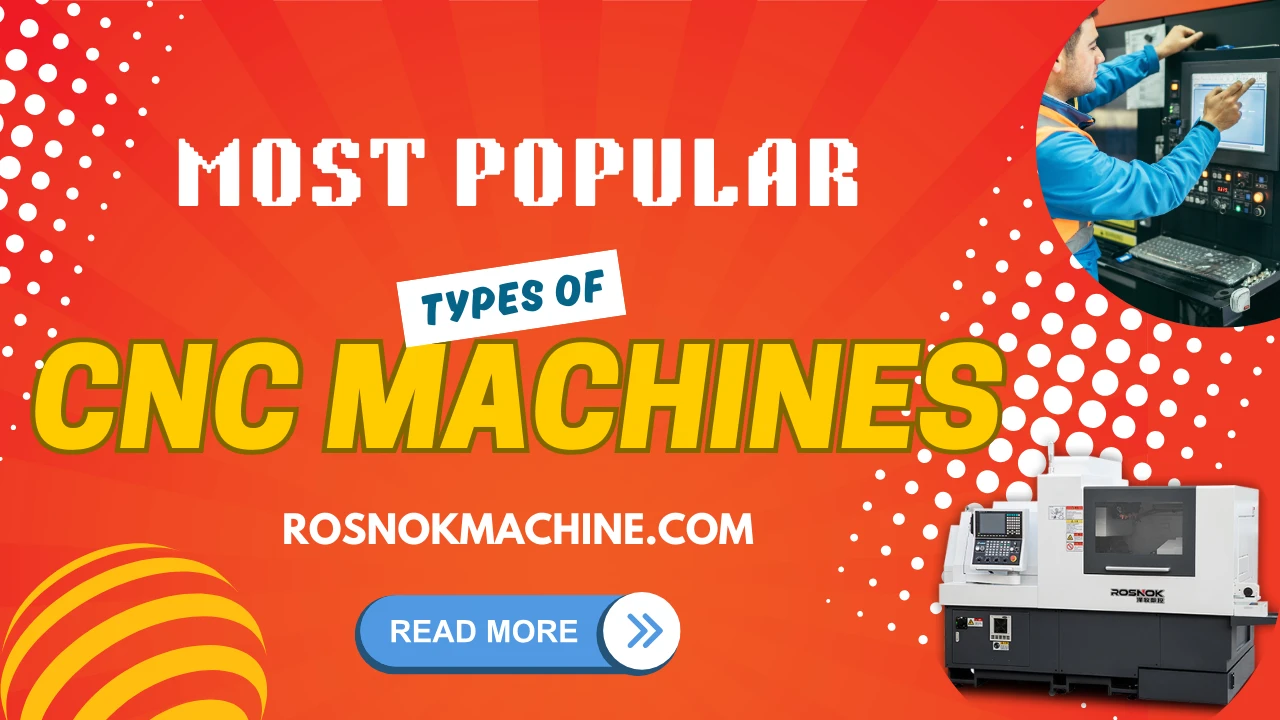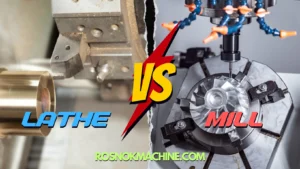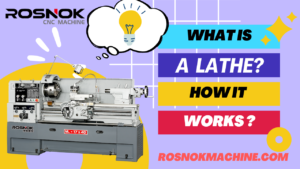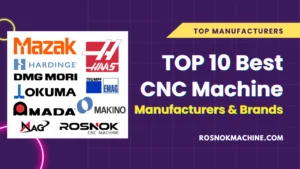Have you ever wondered which types of CNC machines are the most commonly used in manufacturing? With so many CNC machines available, how do you know which ones dominate the industry and why? Whether you’re new to CNC technology or looking to understand which machines are the most widely used, this guide will give you a clear and informative overview.
There are 12 Most Popular types of CNC machines, each designed for specific manufacturing tasks. Whether you’re a seasoned industry professional or just starting in the field, understanding these machines is crucial for staying ahead in today’s competitive market.
In this guide, we’ll explore the most popular CNC machines, their functions, and how they optimize production across different applications. From CNC lathes to plasma cutters, understanding these machines will help you make informed decisions. Let’s dive into the 12 most popular types of CNC machines and explore their applications.
Introduction: What Are CNC Machines?
In today’s fast-paced manufacturing world, CNC (Computer Numerical Control) machines have transformed how products are made. These automated machines operate with extreme precision, producing everything from aerospace components to precision medical implants. But with so many types of CNC machines, what exactly are they, and how do they work?
CNC (Computer Numerical Control) technology automates machining processes by controlling tool movement, spindle speed, feed rates, and other critical machining parameters. It ensures precision, repeatability, and efficiency, allowing machines to execute complex operations with minimal human intervention.
There are many different types of CNC machines, each designed for specific machining tasks. Some specialize in cutting and shaping metal, while others are used for engraving, drilling, or even 3D printing. Whether you’re a manufacturer, engineer, or CNC enthusiast, understanding these machines and their applications is key to staying ahead in modern production.
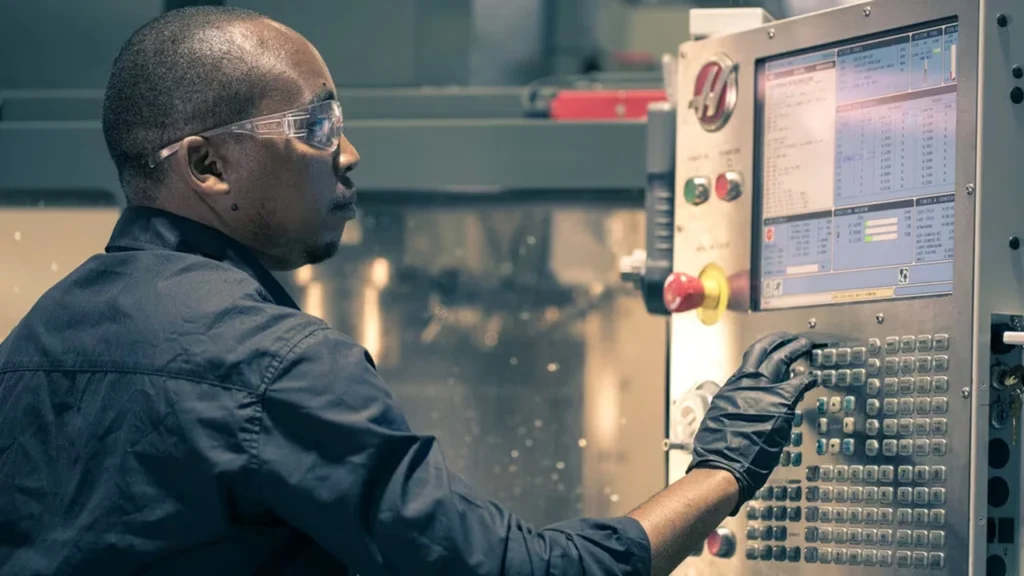
What Are the Different Types of CNC Machines?
CNC machines come in various forms, each designed to handle specific tasks with precision and efficiency. From cutting and drilling to engraving and 3D printing, these machines have revolutionized modern manufacturing. But how many types of CNC machines are there, and what makes them different?
CNC machines can be classified into different types based on how they operate and process materials:
- Rotational CNC Machines – These machines work by rotating the workpiece while a cutting tool shapes it. Examples include CNC lathes and CNC turning centers, which are commonly used for creating cylindrical parts like shafts and bolts.
- Cutting & Milling CNC Machines – These machines use rotary cutting tools to remove material from a stationary workpiece. CNC milling machines and CNC machining centers fall into this category, performing precise drilling, slotting, and shaping operations.
- Thermal Cutting CNC Machines – Machines like CNC laser cutters and CNC plasma cutters use high-energy beams or ionized gas to cut through metal, plastic, or wood with extreme precision and speed.
- Abrasive CNC Machines – These machines use grinding wheels or electrical discharges to shape and refine materials. Examples include CNC grinding machines for surface finishing and CNC Wire EDM (Electrical Discharge Machining) for high-precision cutting of hard metals.
- Additive CNC Machines – Unlike other CNC machines that remove material, CNC 3D printers build objects layer by layer using additive manufacturing technology, allowing for the creation of complex designs with minimal waste.
With so many different types of CNC machines, understanding their capabilities is essential for selecting the right one for your application. In the next section, we’ll explore the 12 most popular types of CNC machines, their functions, and their real-world applications.
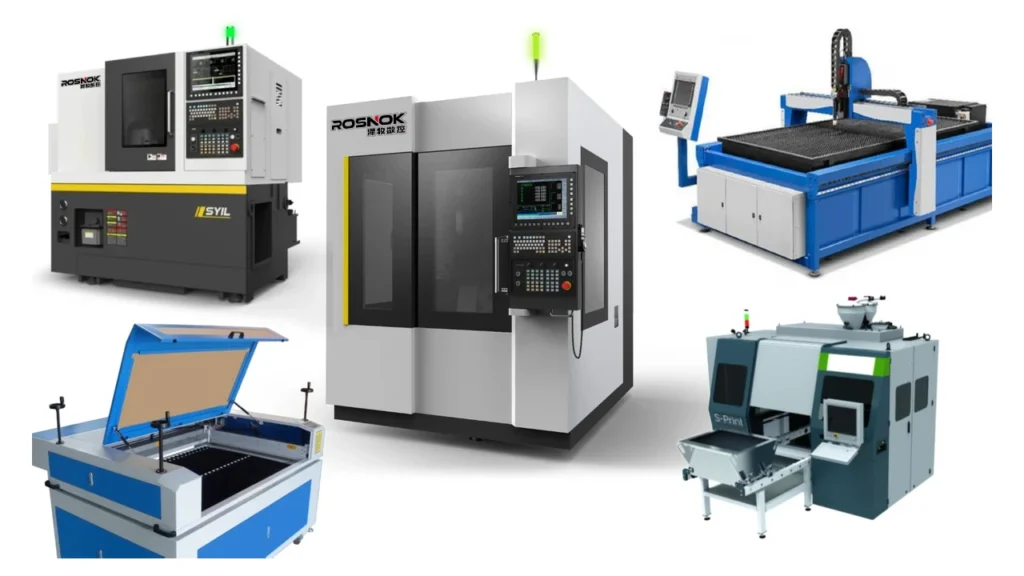
12 Most Popular Types of CNC Machines & Their Functions
CNC machines come in various forms, each designed for specific machining tasks. Whether it’s cutting, engraving, drilling, or shaping materials, CNC machines are essential in modern manufacturing. Below, we’ll explore the 12 most popular types of CNC machines, their functions, working principles, and real-world applications.
1. CNC Lathe Machine
What Is a CNC Lathe Machine?
A CNC lathe machine is a rotational machining tool that spins a workpiece while a stationary cutting tool removes material. Unlike manual lathes, CNC lathes use computer-controlled automation to make precise cuts, drilling, and threading operations.
How It Works
The workpiece is clamped into a rotating spindle.
A computer-controlled cutting tool moves along the workpiece, removing material.
The machine follows programmed toolpaths to achieve high precision and repeatability.
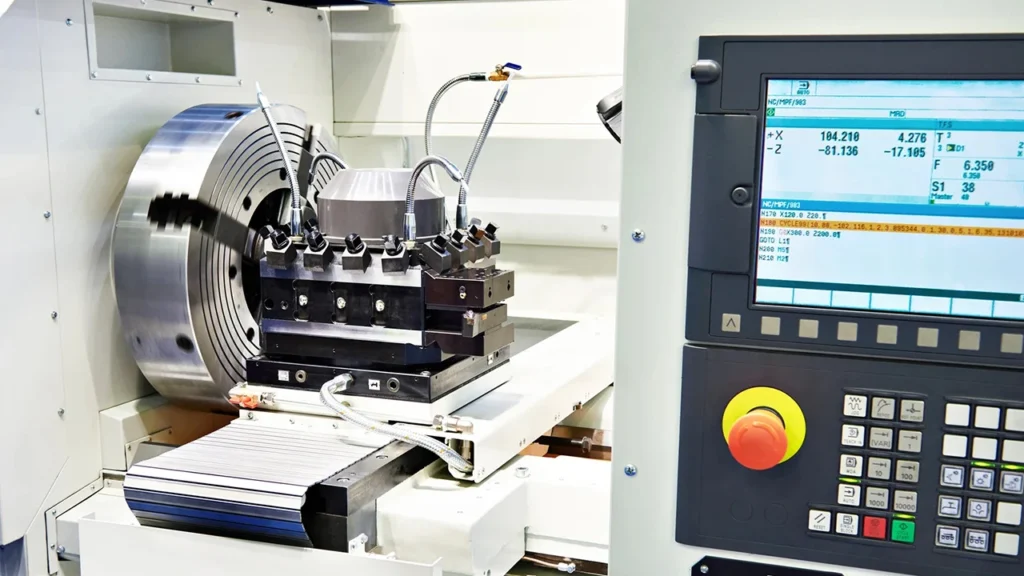
Types of CNC Lathe Machines
- Flat Bed CNC Lathe → Designed for general-purpose machining, providing flexibility for small to medium batch production. It has a horizontal bed structure, making it more suitable for less rigid machining tasks than slant-bed lathes.
- Slant Bed CNC Lathe → Offers higher rigidity, stability, and chip removal efficiency, making it ideal for high-speed precision machining and heavy-duty cutting applications.
- Swiss-Type CNC Lathe → Designed for small, high-precision parts (e.g., watchmaking, medical devices).
- Vertical CNC Lathe → The spindle is vertically aligned, making it ideal for large, heavy, and unbalanced workpieces. The vertical orientation uses gravity to help stabilize the workpiece, reducing deflection and increasing accuracy.
- CNC Turning Center → More advanced than a conventional CNC lathe, capable of multiple machining operations such as turning, milling, drilling, and tapping in a single setup, enhancing productivity.
Common Applications
- Manufacturing cylindrical and conical parts (shafts, rods, screws)
- Threading and boring holes in metal and plastic
- Used in automotive, aerospace, and medical industries
Why It’s Popular
- Fast and efficient for high-volume production
- Ideal for symmetrical parts with high precision
- Capable of multiple machining operations in one setup
2. CNC Milling Machine
What Is a CNC Milling Machine?
A CNC milling machine is used to remove material from a stationary workpiece using rotating cutting tools. Unlike lathes, milling machines cut in multiple directions (X, Y, and Z axes), making them ideal for complex 3D machining.
How It Works
A stationary workpiece is secured on the machine table.
A rotating spindle with cutting tools removes material as it moves along programmed paths.
Some CNC milling machines rotate the workpiece for multi-sided machining (4-axis and 5-axis milling).

Types of CNC Milling Machines
- 3-axis milling machines → Standard for cutting and drilling
- 4-axis milling machines → Adds rotation for curved surfaces
- 5-axis milling machines → Multi-angle machining for complex parts
Common Applications
- Mold-making and die casting
- Aerospace and automotive components
- Metal, plastic, and wood machining
Why It’s Popular
- Extremely versatile for different materials and designs
- Can produce highly detailed and complex parts
- Used for both prototyping and mass production
3. CNC Machining Center
What Is a CNC Machining Center?
A CNC machining center is a highly automated milling machine equipped with automatic tool changers (ATC), coolant systems, and enclosed workspaces. Unlike standard CNC mills, machining centers can perform multiple operations (milling, drilling, tapping, and boring) in a single setup with minimal human intervention.
How It Works
The workpiece is secured on the machine table.
The machine follows programmed instructions, automatically changing tools for different operations.
The system maintains high precision and speed for complex machining.
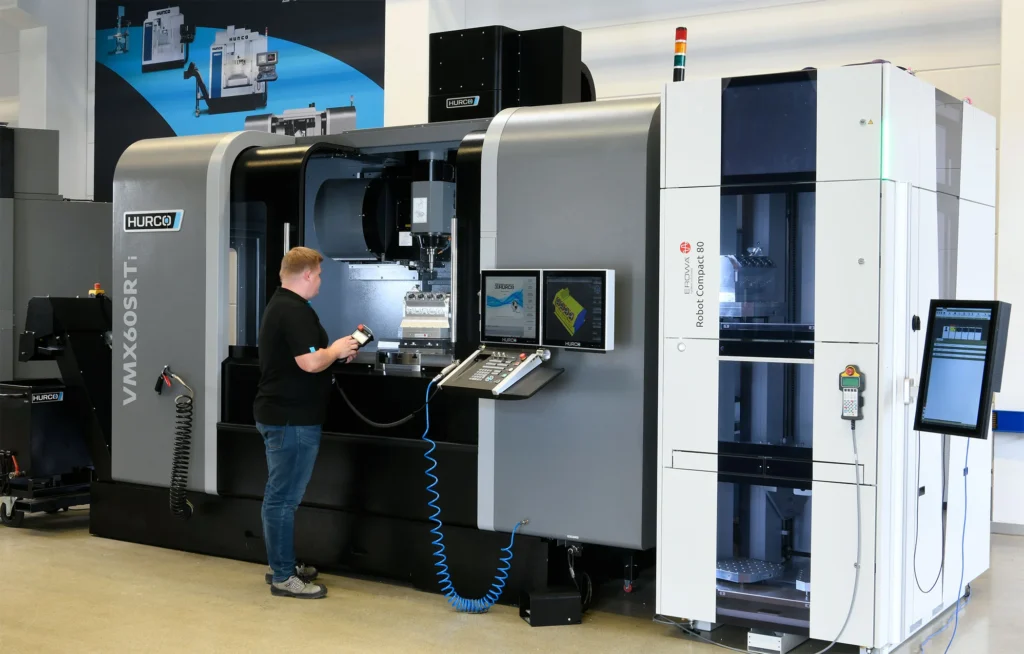
Types of CNC Machining Centers
- Vertical Machining Center (VMC) → The spindle is vertically aligned, ideal for precision milling, drilling, and tapping. Used for aerospace, medical, and die/mold applications.
- Horizontal Machining Center (HMC) → The spindle is horizontally aligned, allowing faster chip removal and efficient cutting on multiple sides. Common in automotive and heavy-duty metal machining.
- 5-Axis Machining Center → Allows machining from five different angles in one setup, ideal for complex aerospace, medical, and high-precision parts.
- Gantry (Bridge-Type) Machining Center → A large-scale machining center with a moving gantry for cutting huge and heavy workpieces, commonly used in shipbuilding and industrial equipment manufacturing.
Common Applications of CNC Machining Centers
- Mass production of precision components
- Aerospace and defense manufacturing
- Mold and die-making
Why It’s Popular
- Eliminates manual tool changes, increasing efficiency
- High precision for complex multi-operation machining
- Suitable for high-volume industrial production
Why This Addition Is Important?
Maintains consistency → Just like CNC lathes and milling machines, machining centers have distinct subcategories.
Explains the different configurations → Helps readers understand why VMCs, HMCs, and 5-axis machining centers differ.
Covers real-world applications → Ensures practical knowledge for beginners and professionals.
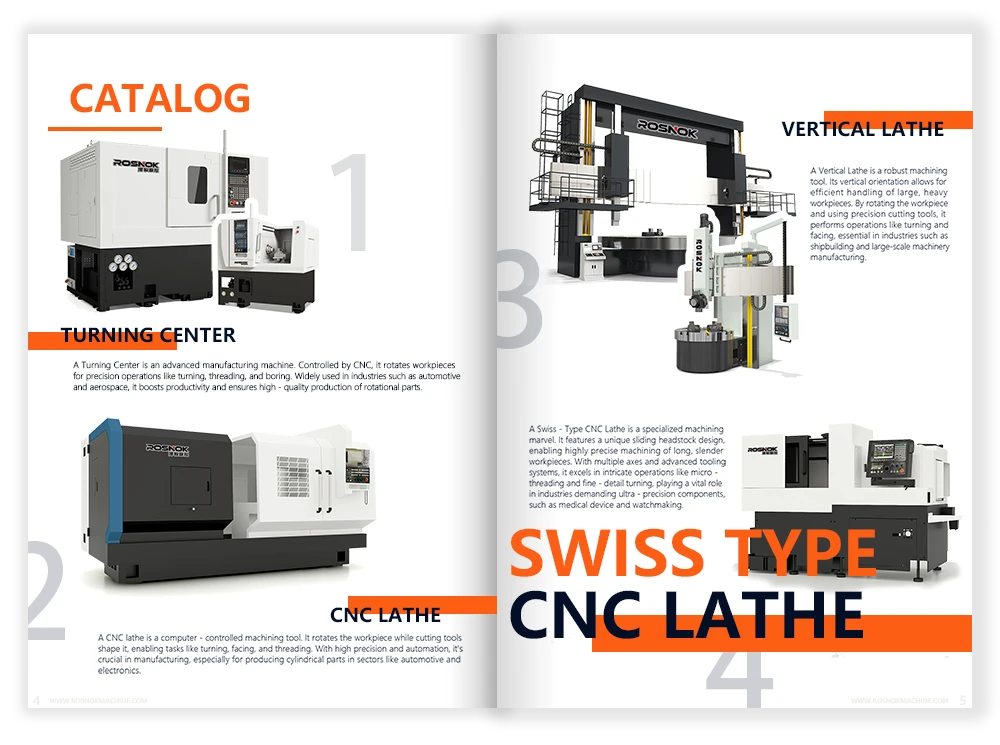
4. CNC Router Machine
What Is a CNC Router Machine?
A CNC router machine is a high-speed, computer-controlled cutting tool primarily used for cutting, engraving, and shaping materials like wood, plastic, composites, and soft metals. Unlike CNC milling machines, which are built for heavy-duty metal cutting, CNC routers are optimized for fast, precise cutting on softer materials.
CNC routers are widely used in woodworking, sign-making, and furniture production, allowing for intricate 2D and 3D designs with exceptional accuracy. They can handle flat sheet materials as well as 3D carvings with specialized tool heads.
How It Works
The workpiece is secured on the router table, and a spinning router bit moves along pre-programmed toolpaths.
The router head moves in multiple axes (X, Y, Z) to cut or engrave the material with extreme precision.
The machine follows G-code instructions to execute detailed designs, grooves, pockets, and profiles.
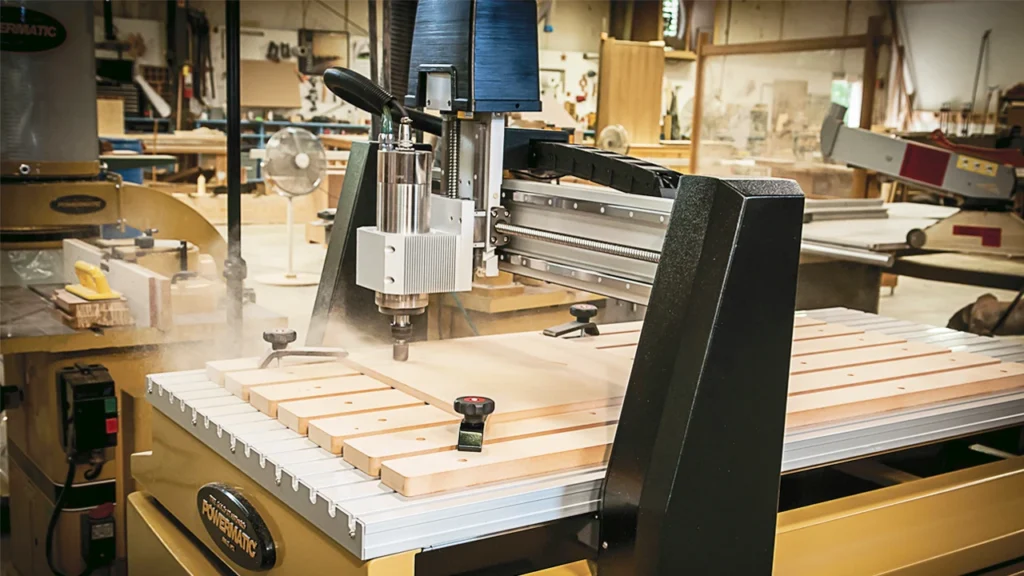
Types of CNC Routers
- 3-Axis CNC Router → Standard for flat sheet cutting and engraving. Moves in X, Y, and Z directions.
- 4-Axis CNC Router → Adds a rotational A-axis, allowing cylindrical cutting and more complex 3D shaping.
- 5-Axis CNC Router → The router head can tilt and rotate, enabling intricate multi-sided machining in a single setup.
- ATC (Automatic Tool Change) CNC Router → Equipped with multiple tools for switching between cutting, drilling, and engraving automatically.
Common Applications
- Furniture and cabinetry production – Cutting, grooving, and engraving wood panels
- Sign-making and decorative engraving – Acrylic, plastic, and metal engraving
- Foam, plastic, and composite material cutting – Used in model-making and packaging
- Architectural design and interior décor – Decorative panels, engravings, and moldings
Why It’s Popular
- Faster cutting speed than CNC milling machines for wood, plastic, and soft metals
- Capable of detailed and decorative engraving for artistic applications
- Can handle both 2D and 3D cutting, increasing versatility
5. CNC Laser Cutting Machine
What Is a CNC Laser Cutting Machine?
A CNC laser cutting machine is a computer-controlled tool that uses a high-powered laser beam to cut, engrave, or etch materials with extreme precision. Unlike CNC routers or milling machines, which use mechanical cutting tools, laser cutters rely on focused light energy to vaporize or melt materials, resulting in clean, smooth, and highly detailed cuts.
CNC laser cutters are widely used in metal fabrication, electronics, aerospace, automotive, and sign-making industries due to their ability to cut intricate patterns with minimal material waste.
How It Works
The laser beam is generated from a high-power CO₂, fiber, or diode laser source.
A series of mirrors and lenses focus the beam onto the material surface.
The high-energy laser melts, vaporizes, or burns through the material as the machine follows pre-programmed cutting paths.
A gas assist system (oxygen, nitrogen, or air) blows away molten debris, ensuring a clean, precise cut.

Types of CNC Laser Cutting Machines
- CO₂ Laser Cutter → Best for non-metal materials like wood, acrylic, plastic, leather, and fabric.
- Fiber Laser Cutter → High-powered laser used for cutting metals like stainless steel, aluminum, brass, and copper.
- Diode Laser Cutter → A compact, cost-effective solution for engraving and low-power cutting applications.
- Hybrid Laser Cutter → Combines laser and mechanical cutting for versatile material processing.
Common Applications
- Sheet metal cutting – Used in automotive, aerospace, and industrial manufacturing
- Engraving and etching – Personalizing wood, glass, acrylic, and metal products
- Sign-making and branding – Cutting detailed company logos, letters, and decorative elements
- Medical device manufacturing – Creating precision components for surgical tools and implants
Why It’s Popular
- Extremely precise cutting with minimal waste
- Non-contact process prevents tool wear
- Capable of cutting fine details and intricate designs
- Fast cutting speed, making it ideal for mass production
6. CNC Plasma Cutting Machine
What Is a CNC Plasma Cutting Machine?
A CNC plasma cutting machine is a computer-controlled cutting system that uses a high-temperature plasma arc to slice through electrically conductive materials like steel, aluminum, brass, and copper. Plasma cutting is one of the most efficient methods for thick metal cutting, making it a preferred choice in metal fabrication, shipbuilding, automotive, and construction industries.
Unlike laser cutters, which use light energy to vaporize material, plasma cutters work by generating a superheated ionized gas (plasma) that melts through metal at extremely high speeds.
How It Works
The machine creates an electric arc between the plasma torch and the workpiece, heating the gas (oxygen, nitrogen, or argon) to extreme temperatures.
The ionized gas converts into plasma, which reaches temperatures of up to 30,000°C.
The plasma arc melts the material, and a high-velocity jet blows away molten metal, creating a clean cut.
The CNC system controls the plasma torch’s movement, following pre-programmed paths for accurate cutting.
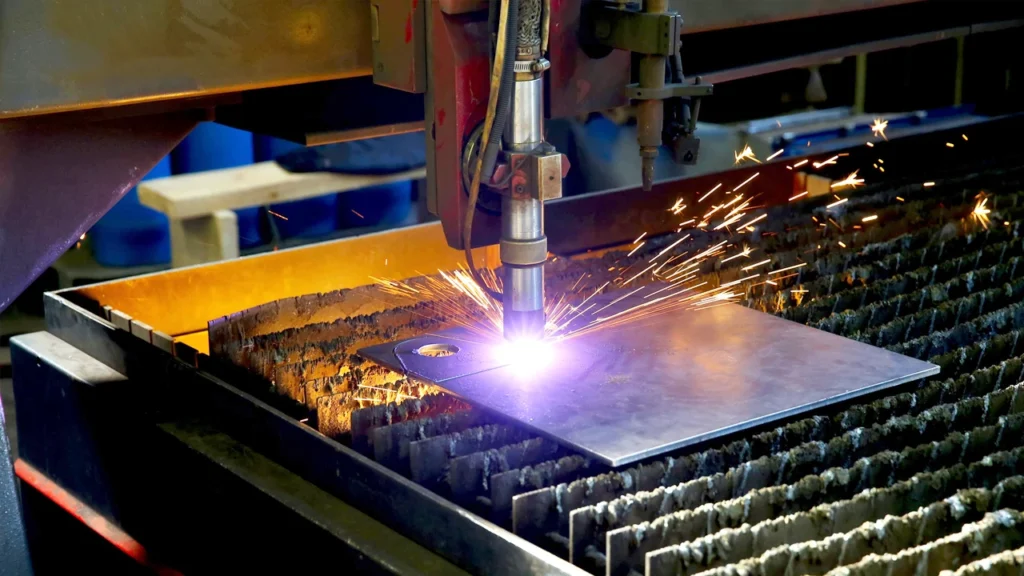
Types of CNC Plasma Cutting Machines
- 2D CNC Plasma Cutter → Used for cutting flat metal sheets into precise shapes.
- 3D CNC Plasma Cutter → Cuts at multiple angles, used for pipe and structural beam cutting.
- Portable CNC Plasma Cutter → A compact, mobile solution for on-site metal fabrication.
- High-Definition Plasma Cutter (HD Plasma) → Delivers ultra-precise cuts with a narrow heat-affected zone.
Common Applications
- Cutting steel plates and structural metals – Used in shipbuilding, bridge construction, and heavy industry
- Custom metal fabrication – Cutting metal frames, doors, and machine parts
- Automotive and aerospace industries – Fabricating chassis components, brackets, and industrial equipment
- Artistic and decorative metalwork – Creating custom metal signs, sculptures, and perforated panels
Why It’s Popular
- Cuts thick metal quickly and efficiently
- More cost-effective than laser cutting for heavy-duty applications
- Minimal material waste compared to mechanical cutting
- Suitable for large-scale industrial fabrication
7. CNC Grinding Machine
What Is a CNC Grinding Machine?
A CNC grinding machine is a computer-controlled tool that uses abrasive wheels to precisely shape and finish materials. Unlike milling and turning machines, which use cutting tools, grinding machines remove material by abrasion, producing exceptionally smooth surfaces and precise dimensions. These machines are widely used in aerospace, automotive, tool-making, and medical industries where ultra-precise tolerances are required.
CNC grinders are essential for finishing metal parts, sharpening tools, and producing high-precision components. They can process hardened materials that conventional cutting tools struggle to machine.
How It Works
The workpiece is secured on a rotating or fixed table.
A computer-controlled abrasive grinding wheel spins at high speeds, removing material layer by layer.
The CNC system precisely controls the movement of the grinding wheel and workpiece, ensuring tight tolerances and a smooth finish.
Some CNC grinders use coolant systems to reduce heat buildup and prevent damage to the workpiece.

Types of CNC Grinding Machines
- Surface Grinding Machine → Produces flat, smooth surfaces on metal or non-metallic workpieces.
- Cylindrical Grinding Machine → Used for grinding external and internal cylindrical parts such as shafts and rollers.
- Centerless Grinding Machine → No need for workpiece clamping, making it ideal for high-speed production of rods, tubes, and bars.
- Tool & Cutter Grinding Machine → Specially designed for sharpening and reshaping cutting tools like drills and end mills.
- Gear Grinding Machine → Used in the automotive and aerospace industries for high-precision gear manufacturing.
Common Applications
- Finishing engine components – Pistons, crankshafts, and camshafts
- Grinding high-precision aerospace parts – Turbine blades, landing gear components
- Sharpening industrial cutting tools – Drills, reamers, and milling cutters
- Producing ultra-smooth surfaces for medical and optical equipment
Why It’s Popular
- Widely used in aerospace, automotive, and tool-making industries
- Achieves ultra-high precision and smooth finishes
- Essential for machining hardened metals and difficult-to-cut materials
- Improves tool life and reduces friction in moving parts
8. CNC Wire EDM (Electrical Discharge Machining) Machine
What Is a CNC Wire EDM Machine?
A CNC Wire EDM (Electrical Discharge Machining) machine is a computer-controlled tool that uses electrical sparks (discharges) to cut through metal with extreme precision. Unlike conventional cutting methods, EDM is a non-contact process, meaning no physical cutting tool touches the material.
CNC Wire EDM machines are commonly used in aerospace, medical, mold-making, and high-precision tool industries, where intricate cuts, tight tolerances, and hardened metals need to be machined without deformation.
How It Works
A thin brass or copper wire acts as an electrode and is fed through the machine.
The workpiece is submerged in a dielectric fluid, which prevents overheating and removes debris.
An electrical current passes between the wire and workpiece, creating thousands of high-temperature sparks that vaporize the metal without physical contact.
The CNC system precisely controls the movement of the wire, ensuring high-precision cuts with tolerances as tight as ±0.002 mm.

Types of CNC Wire EDM Machines
Wire EDM Machine → Uses a continuous wire to create highly detailed and precise cuts.
Sinker EDM Machine → Uses a custom-shaped electrode instead of a wire, ideal for engraving and cavity forming.
Fast Hole Drilling EDM → Designed for drilling tiny holes in hardened metals, commonly used for jet engine components and medical implants.
Common Applications
- Manufacturing complex molds and dies – Used in plastic injection molding and metal stamping
- Cutting aerospace-grade materials – Titanium, Inconel, hardened steel
- Creating medical implants and surgical tools – Stents, orthopedic devices, and precision surgical instruments
- Micro-machining electronic components – Circuit boards, semiconductors, and precision connectors
Why It’s Popular
- Cuts hardened metals without generating heat stress
- Achieves extreme precision, ideal for intricate and fine-detail machining
- No mechanical force applied, eliminating tool wear and material distortion
- Allows for highly complex and delicate designs that traditional cutting tools cannot achieve
9. CNC Boring Machine
What Is a CNC Boring Machine?
A CNC boring machine is a computer-controlled tool used to enlarge pre-existing holes in metal, wood, or plastic with extreme accuracy. Unlike drilling machines, which create new holes, boring machines refine, expand, and smooth out holes for precise fits in mechanical components.
These machines are widely used in automotive, heavy machinery, aerospace, and industrial manufacturing, where high-precision hole-making is crucial for engine blocks, machine parts, and structural components.
How It Works
A pre-drilled hole is positioned beneath a rotating boring tool.
The CNC system guides the boring head to expand the hole to the desired diameter.
The tool can adjust depth, angle, and diameter for precision fitting.
Some CNC boring machines use multiple tools simultaneously, enabling complex machining in one setup.

Types of CNC Boring Machines
- Horizontal CNC Boring Machine → The spindle is mounted horizontally, making it ideal for machining large, heavy components such as engine blocks and industrial equipment.
- Vertical CNC Boring Machine → The spindle is vertically aligned, best for boring deep holes in tall workpieces, such as hydraulic cylinders and industrial molds.
- Jig Boring Machine → Ultra-precise machine used for finishing holes with extreme accuracy, typically in aerospace and tool-making industries.
- Table-Type CNC Boring Machine → The workpiece is fixed on a stationary table, while the spindle moves in multiple axes for high-precision machining.
Common Applications
- Enlarging holes in engine blocks and cylinder heads
- Machining hydraulic and pneumatic components
- Precision boring for aerospace structures and defense equipment
- Creating precise holes for industrial machine assembly
Why It’s Popular
- Enables extreme accuracy in hole-making processes
- Handles large and heavy workpieces efficiently
- Essential for high-precision assembly and mechanical fit
- Reduces manual labor by automating deep hole boring operations

10. CNC Drilling Machine
What Is a CNC Drilling Machine?
A CNC drilling machine is a computer-controlled tool designed to create precise, high-speed holes in various materials, including metal, wood, plastic, and composites. Unlike manual drilling machines, CNC drilling machines automate the process, ensuring repeatable accuracy, efficiency, and consistency.
CNC drilling is widely used in aerospace, automotive, electronics, and construction industries, where accurate hole placement and depth are critical for structural integrity and component assembly.
How It Works
The workpiece is fixed on the drilling table or rotary fixture.
The CNC system guides the drill bit to specific locations, ensuring exact hole positioning.
The spindle lowers the rotating drill bit into the material, following pre-programmed depths and speeds.
The machine automatically retracts the drill and moves to the next hole, reducing manual labor and errors.
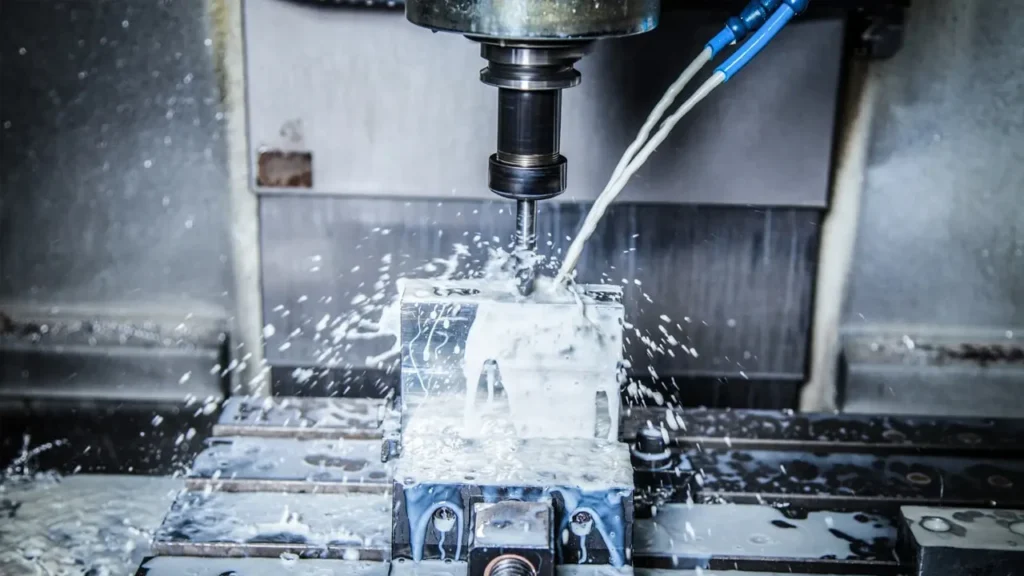
Types of CNC Drilling Machines
- Vertical CNC Drilling Machine → The spindle is vertically aligned, best for straight-line hole drilling in flat materials and plates.
- Horizontal CNC Drilling Machine → The spindle is horizontally positioned, ideal for deep hole drilling in cylindrical or large workpieces.
- Multi-Spindle CNC Drilling Machine → Features multiple drill bits working simultaneously, used for mass production of drilled components.
- CNC Deep Hole Drilling Machine → Designed for precision drilling of deep holes in aerospace and automotive components.
- CNC Radial Drilling Machine → The drill head can move radially, allowing drilling on large and complex parts.
Common Applications
- Drilling mounting holes in metal and plastic parts
- Creating heat dissipation holes in electronic circuit boards
- Boring deep holes in aerospace engine components
- Producing high-precision holes for machine parts and automotive frames
Why It’s Popular
- Highly precise and consistent drilling for industrial production
- Automated tool change and hole positioning increase efficiency
- Handles a wide range of materials, from soft plastics to hardened metals
- Reduces operator fatigue and human error in mass production
11. CNC Water Jet Cutting Machine
What Is a CNC Water Jet Cutting Machine?
A CNC water jet cutting machine is a computer-controlled tool that uses a high-pressure jet of water mixed with abrasives to cut through various materials. Unlike plasma and laser cutters, which generate extreme heat, water jet cutting is a cold-cutting process, making it ideal for heat-sensitive materials such as rubber, glass, stone, composites, and metals.
These machines are widely used in aerospace, automotive, construction, and architectural industries, where precision cutting without material distortion is required.
How It Works
The water is pressurized up to 60,000 PSI (pounds per square inch) using a high-pressure pump.
A small nozzle focuses the water stream and mixes it with abrasive materials (like garnet or aluminum oxide) for enhanced cutting power.
The CNC system controls the movement of the water jet, guiding it along pre-programmed toolpaths.
The high-speed jet erodes the material, cutting through even the hardest metals and stones without causing heat damage.

Types of CNC Water Jet Cutting Machines
- Pure Water Jet Cutter → Uses only high-pressure water, suitable for cutting soft materials like foam, rubber, food products, and paper.
- Abrasive Water Jet Cutter → Uses a water-abrasive mixture to cut hard materials such as metal, stone, glass, and ceramics.
- 5-Axis CNC Water Jet Cutter → Allows for multi-angle cuts, making it ideal for complex 3D components.
Common Applications
- Cutting aerospace components – Titanium, Inconel, and composites
- Architectural and artistic designs – Decorative glass, tile, and metal panels
- Medical device manufacturing – Precision cutting of surgical tools and implants
- Food industry applications – Clean cutting of frozen foods without contamination
Why It’s Popular
- No heat-affected zones, preventing material warping or distortion
- Can cut almost any material, including metals, plastics, ceramics, and glass
- Environmentally friendly – No toxic fumes or thermal damage
- High precision and smooth edges, reducing the need for secondary finishing
12. CNC 3D Printing Machine
What Is a CNC 3D Printing Machine?
A CNC 3D printing machine, also known as an additive manufacturing machine, is a computer-controlled device that creates three-dimensional objects by depositing material layer by layer. Unlike traditional CNC machines, which remove material through cutting or grinding, 3D printers build objects from the ground up using plastic, metal, ceramic, or composite materials.
CNC 3D printers are widely used in prototyping, aerospace, medical, automotive, and consumer product industries due to their ability to produce complex geometries quickly and efficiently.
How It Works
A 3D model is created in CAD (Computer-Aided Design) software and converted into a digital file.
The CNC system slices the model into layers and generates toolpaths for the print head.
The printer deposits material layer by layer, using methods such as extrusion, powder fusion, or resin curing.
The object is built progressively, and post-processing (such as polishing or heat treatment) may be applied if necessary.

Types of CNC 3D Printing Machines
- FDM (Fused Deposition Modeling) Printer → Uses plastic filament (PLA, ABS, PETG) melted through a heated nozzle to build objects layer by layer.
- SLA (Stereolithography) Printer → Uses a laser to cure liquid resin, creating highly detailed prints.
- SLS (Selective Laser Sintering) Printer → Uses a laser to fuse powdered material, commonly used for metal and industrial-grade components.
- DMLS (Direct Metal Laser Sintering) Printer → Specializes in printing fully dense metal parts for aerospace, medical, and high-performance applications.
- Multi-Material 3D Printer → Allows printing with different materials simultaneously, improving structural integrity and aesthetics.
Common Applications
- Rapid prototyping for product development – Creating design prototypes before full-scale production
- Aerospace and automotive manufacturing – Producing lightweight, complex metal parts
- Medical and dental applications – 3D printing of prosthetics, implants, and surgical guides
- Custom and on-demand production – Small-batch manufacturing without tooling costs
Why It’s Popular
- Reduces material waste compared to subtractive CNC machining
- Creates highly complex designs that are impossible with traditional methods
- Faster production cycle, making it ideal for prototyping and rapid iteration
- Enables cost-effective, small-batch manufacturing without expensive tooling
Choosing the Right CNC Machine for Your Needs
With so many types of CNC machines available, choosing the right one depends on your specific application, material requirements, and production goals. Below, we’ll explore the key factors to consider when selecting a CNC machine.
What Are Your Machining Needs?
Before investing in a CNC machine, define what kind of machining operations you need. Different types of CNC machines excel at different tasks, whether it’s milling, turning, cutting, or engraving:
- CNC Lathe Machine → Best for turning, threading, and cylindrical shaping
- CNC Milling Machine → Ideal for multi-axis milling, drilling, and complex part machining
- CNC Router Machine → Suitable for wood, plastic, and lightweight metal engraving
- CNC Laser & Plasma Cutting Machines → Great for precision sheet metal cutting
- CNC Grinding Machine → Essential for finishing and precision surface grinding
- CNC 3D Printer → Perfect for rapid prototyping and additive manufacturing
Tip: If your application requires multiple machining operations, consider a CNC Machining Center or CNC Turning Center, which combine multiple capabilities in one machine.

What Materials Will You Work With?
- Metals (Steel, Aluminum, Titanium, Brass) → Choose a CNC milling machine, CNC lathe, CNC plasma cutter, or CNC grinding machine.
- Wood & Soft Materials → A CNC router machine is ideal for carving, cutting, and engraving.
- Plastics & Composites → CNC routers and CNC laser cutters work best for detailed cutting and engraving.
- Heat-Sensitive Materials (Glass, Rubber, Food Processing) → A CNC water jet cutting machine ensures cold cutting without warping.
- 3D Printed Prototyping → A CNC 3D printer is best for rapid prototyping and additive manufacturing.
Tip: The hardness, thickness, and heat sensitivity of your material will influence your machine choice.


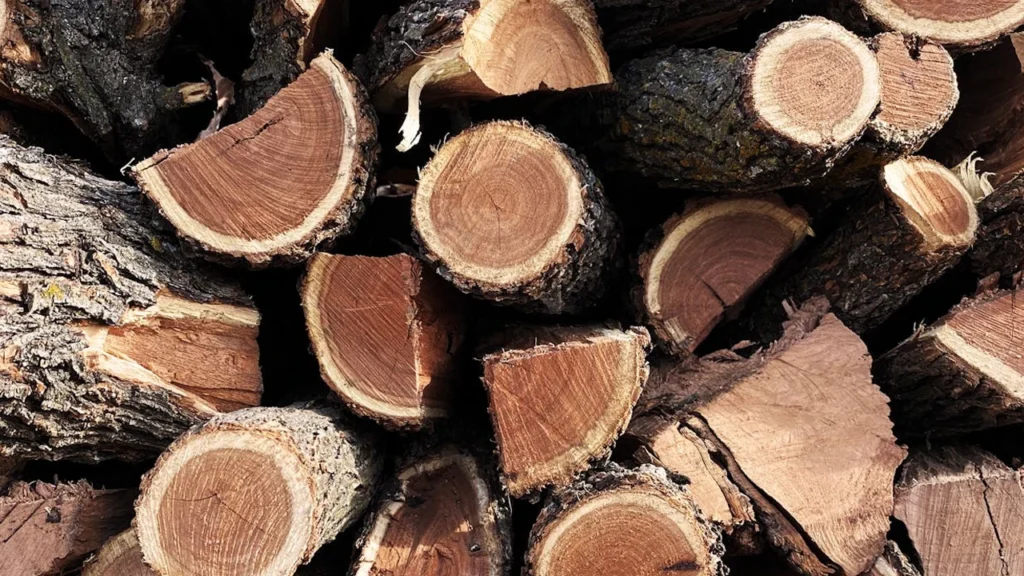
What Level of Precision Do You Need?
If your industry demands extreme accuracy and fine tolerances, certain CNC machines outperform others:
- High Precision (±0.002 mm or better) → CNC Grinding Machine, CNC Wire EDM, 5-Axis CNC Machining Center
- Medium Precision (±0.01 mm) → CNC Lathe, CNC Milling Machine, CNC Water Jet Cutting Machine
- Standard Precision (±0.1 mm) → CNC Router, CNC Laser Cutting Machine, CNC Plasma Cutting Machine
Tip: Aerospace, medical, and defense industries often require 5-axis CNC machining, EDM machining, or CNC grinding for their high-precision demands.
Production Volume & Efficiency
Are you producing parts in high volume, or do you need custom one-off pieces?
- High-Volume, Automated Production → Consider a CNC Machining Center, CNC Turning Center, or Multi-Spindle CNC Lathe.
- Small-Batch Production or Prototyping → A CNC 3D Printer, CNC Milling Machine, or CNC Router may be more cost-effective.
- Large Sheet Metal Processing → A CNC Plasma Cutter, CNC Laser Cutter, or CNC Water Jet Cutter is best for batch cutting.
Tip: If speed is a priority, choose a machine with high spindle speeds, automatic tool changers (ATC), and multi-axis movement.
Budget & Cost Considerations
CNC machines range from a few thousand dollars to over a million dollars, depending on their features, size, and complexity:
- Entry-Level CNC Machines ($3,000 – $20,000) → Small CNC routers, hobbyist 3D printers, compact CNC mills and lathe
- Mid-Range CNC Machines ($20,000 – $100,000) → CNC lathes, machining centers, industrial-grade routers
- High-End CNC Machines ($100,000 – $1,000,000+) → 5-axis machining centers, large CNC plasma/laser cutters, multi-axis CNC mills
Tip: Consider the total cost of ownership, including maintenance, tooling, software, and operator training.

Ease of Use & Software Compatibility
- Beginner-Friendly Machines → CNC Routers, Entry-Level CNC Milling Machines, CNC Laser Cutters
- Advanced Programming Required → CNC 5-Axis Machining Centers, CNC EDM Machines, Multi-Spindle Lathes
Common CNC Software:
- CAD Software (AutoCAD, SolidWorks) → For designing 3D models
- CAM Software (Fusion 360, Mastercam) → For generating CNC toolpaths
- Machine Control Software (Fanuc, Siemens, Mitsubishi, Heidenhain) → For executing CNC programs
Tip: User-friendly interfaces and pre-installed software can reduce the learning curve.
Final Decision: Which CNC Machine Is Best for You?
Choosing the right CNC machine depends on your specific needs, materials, precision requirements, and production goals. Here’s a quick summary:
| Machining Need | Best CNC Machine |
|---|---|
| Cutting, Engraving, Carving | CNC Router, CNC Laser Cutter |
| Precision Metal Parts | CNC Milling Machine, CNC Machining Center |
| Cylindrical Workpieces | CNC Lathe, CNC Turning Center |
| Sheet Metal Cutting | CNC Plasma Cutter, CNC Water Jet Cutter |
| High-Precision Surface Finishing | CNC Grinding Machine |
| Prototyping & Small-Batch Production | CNC 3D Printer |
| Complex & Multi-Sided Machining | 5-Axis CNC Machining Center, CNC Wire EDM |
Tip: Always factor in your budget, required precision, and production capacity before making a purchase.

Conclusion
Final Thoughts on CNC Machines
CNC machines have revolutionized modern manufacturing by offering precision, automation, and efficiency across a wide range of industries. From CNC lathes and milling machines to laser cutters and 3D printers, each type of CNC machine is designed for a specific machining need.
By understanding the different types of CNC machines, their applications, and the factors that affect their selection, you can make an informed decision when investing in CNC technology. Whether you’re working with metal, wood, plastics, or composites, choosing the right CNC machine will improve production speed, quality, and cost efficiency.
Why Choose Rosnok CNC Machines?
At Rosnok, we specialize in high-quality, precision-engineered CNC machines that meet the demands of industrial manufacturing, precision machining, and custom production. Our cutting-edge CNC solutions are designed for efficiency, durability, and performance, making them the ideal choice for businesses looking to scale their production with confidence.

What Sets Rosnok Apart?
- Comprehensive CNC Machine Selection → We offer a full range of CNC machines, including CNC lathes, milling machines, machining centers, boring Machine, and more.
- Superior Build Quality → Our machines use premium components to ensure precision, reliability, and long service life.
- Customization Options → Need a customized CNC machine? We offer tailor-made solutions to fit your specific manufacturing needs.
- Advanced CNC Control Systems → We integrate industry-leading control systems like Fanuc, Siemens, Mitsubishi, and Sytec for seamless operation.
- After-Sales Support & Training → Our expert team provides technical support, training, and maintenance services, ensuring maximum uptime and efficiency.
- Competitive CNC Machine Prices → Rosnok offers high-performance CNC machines at competitive prices, ensuring great value for your investment.
Get Started with Rosnok CNC Machines
Choosing the right CNC machine can be overwhelming, but Rosnok makes it easy. Whether you need a high-precision CNC lathe, a powerful machining center, or a custom CNC machine, we have the perfect solution for your production needs.
Contact us today to explore our CNC machine range and take your manufacturing to the next level.

FAQ
Before we wrap up, here are some frequently asked questions about CNC machines to help clarify a few common concerns and support you in choosing the right solution for your workshop or production needs.
Which CNC machine is best for prototyping?
CNC milling machines and CNC 3D printing machines are ideal for prototyping. CNC mills offer high precision and material versatility, while 3D printers allow fast iteration with minimal setup, especially for complex or custom parts.
Do all CNC machines use the same programming language?
No. While most CNC machines use G-code, some types—like CNC routers or 3D printers—may use modified or simplified versions. High-end machines may support proprietary or CAM-specific code formats, depending on the controller.
Are CNC machines suitable for small workshops?
Yes. Many compact CNC machines are designed for small-scale production, prototyping, or hobbyist use. CNC routers, benchtop milling machines, and desktop lathes are popular in small workshops due to their size, cost, and ease of use.

